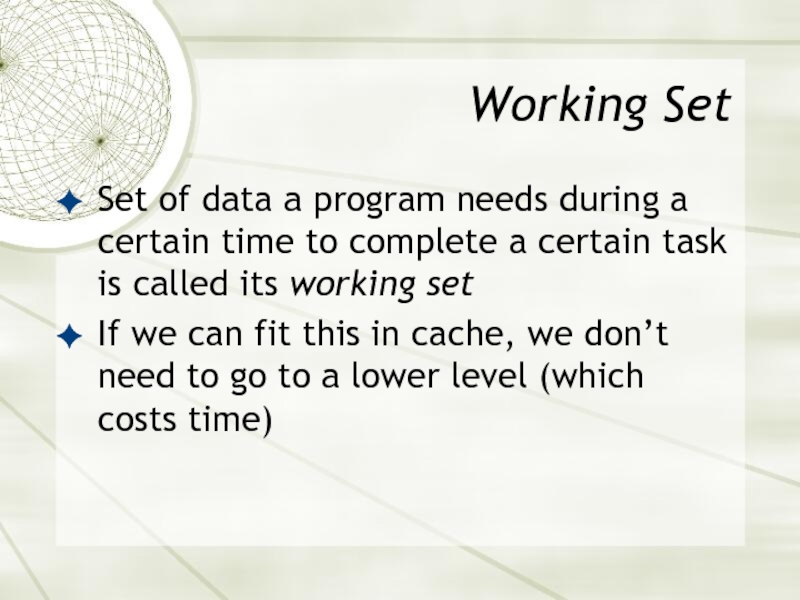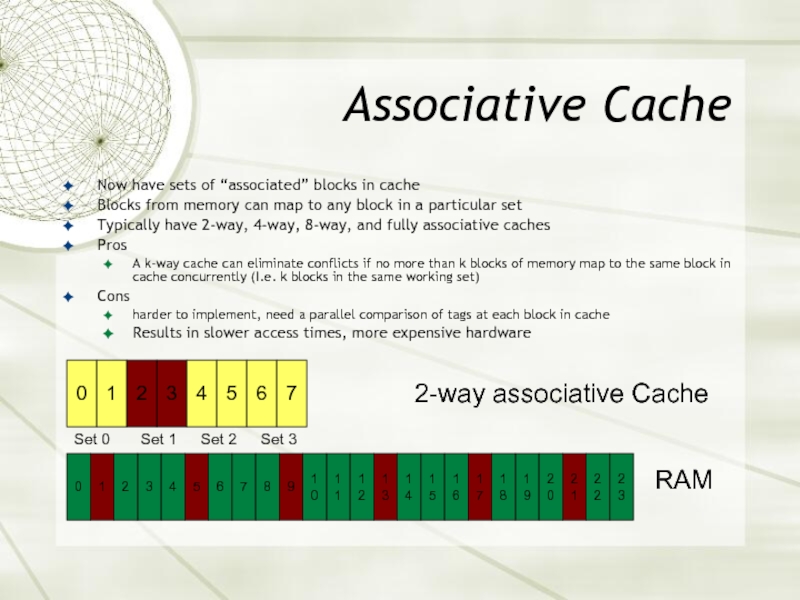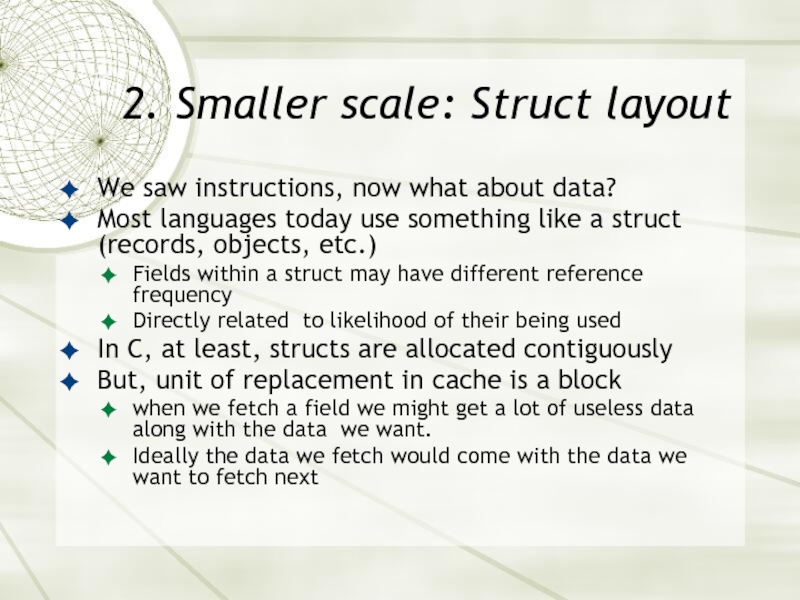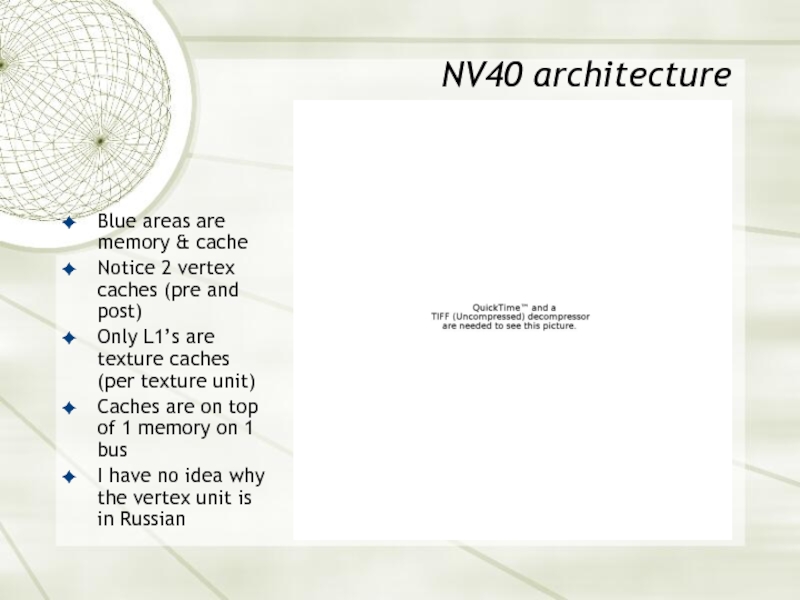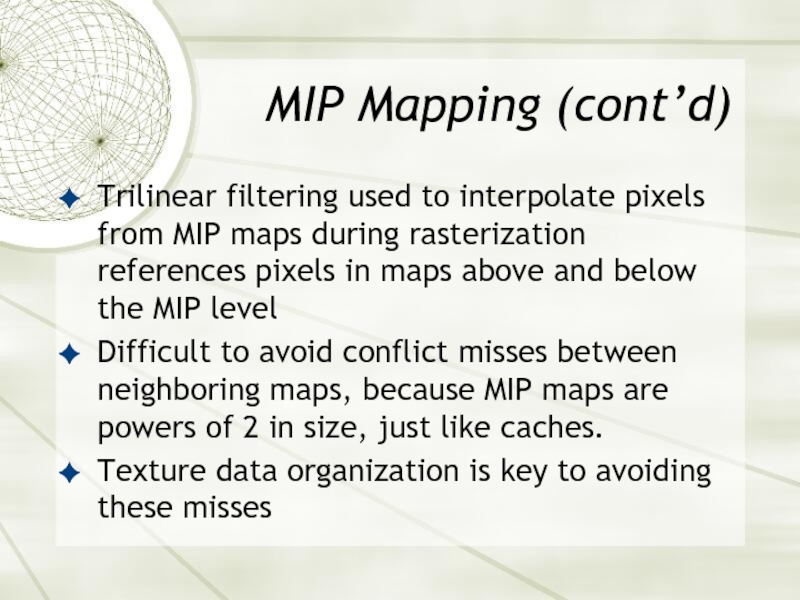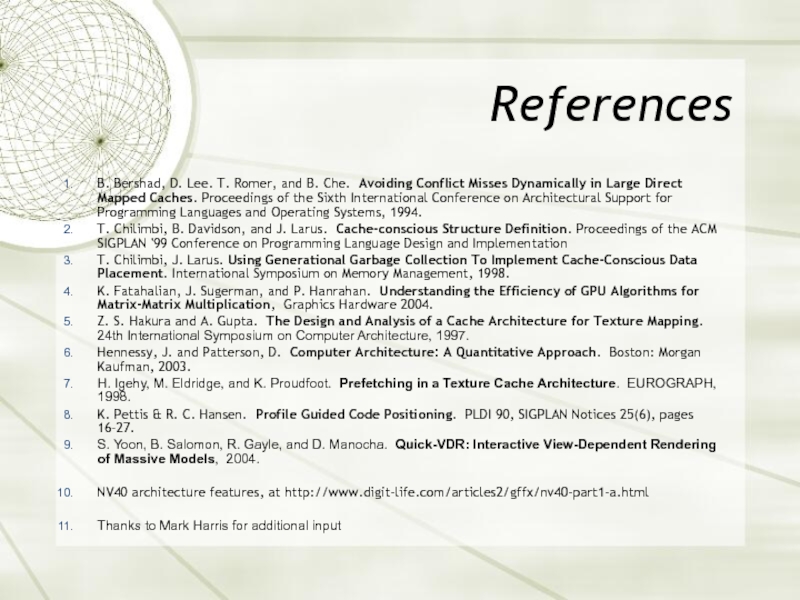- Главная
- Разное
- Дизайн
- Бизнес и предпринимательство
- Аналитика
- Образование
- Развлечения
- Красота и здоровье
- Финансы
- Государство
- Путешествия
- Спорт
- Недвижимость
- Армия
- Графика
- Культурология
- Еда и кулинария
- Лингвистика
- Английский язык
- Астрономия
- Алгебра
- Биология
- География
- Детские презентации
- Информатика
- История
- Литература
- Маркетинг
- Математика
- Медицина
- Менеджмент
- Музыка
- МХК
- Немецкий язык
- ОБЖ
- Обществознание
- Окружающий мир
- Педагогика
- Русский язык
- Технология
- Физика
- Философия
- Химия
- Шаблоны, картинки для презентаций
- Экология
- Экономика
- Юриспруденция
Caching Architectures and Graphics Processing презентация
Содержание
- 1. Caching Architectures and Graphics Processing
- 2. Overview Cache Crash Course Quick review of
- 3. Part I: Cache Review Why Cache? CPU/GPU
- 4. So what to do? DRAM not the
- 5. Use memory hierarchy Small, fast memory close
- 6. Locality How does this speed things up?
- 7. Working Set Set of data a program
- 8. Cache Implementation Cache is transparent CPU still
- 9. Direct mapped cache Blocks of memory map
- 10. Associative Cache Now have sets of “associated”
- 11. Fully associative cache Any block in memory
- 12. Measuring misses Need some way to itemize
- 13. Compulsory Misses Caused when data first comes
- 14. Conflict Misses Caused when data needs to
- 15. Capacity Misses If the cache cannot contain
- 16. Part 2: Some traditional cache optimizations Not
- 17. 1. Compile-time code layout Want to optimize
- 18. Map profile data to the code Pettis
- 19. Lay out code based on chains Try
- 20. 2. Smaller scale: Struct layout We saw
- 21. Split structs for better prefetching Chilimbi suggests
- 22. 3. Dynamic approach: Garbage collection Chilimbi
- 23. More garbage Garbage collector copies data when
- 24. Other dynamic approaches Similar techniques suggested for
- 25. Big picture Things to think about when
- 26. Part 3: Caching on the GPU Architectural
- 27. GPU Pipeline Recall GPU pipeline at high
- 28. NV40 architecture Blue areas are memory &
- 29. Some points about the architecture Seems pretty
- 30. GPU Optimmization example: Texture cache on the
- 31. MIP Mapping Textures on card are stored
- 32. MIP Mapping (cont’d) Trilinear filtering used to
- 33. Rasterization Another pitfall for texture caches We
- 34. Solution: blocking Igehy, et. al. use a
- 36. Locality in the texture representation First level
- 37. Rasterization direction Igehy architecture uses 2 banks
- 38. Matrix-Matrix multiplication GPU implementations so far: Larsen,
- 39. Cache pitfall in matrix-matrix multiply Imagine each
- 40. Typical solution Use blocking to compute
- 41. Optimizing on the GPU Fatahalian, et. al.
- 42. Performance ATLAS profiles a CPU and compiles
- 43. Bandwidth Cards aren’t operating too far from peak bandwidth ATI Multi is above 95%
- 44. GPU Utilization & Bandwidth GPU’s get no
- 45. Shaders limit GPU utilization Paper tried blocking
- 46. How to increase bandwidth Igehy, et. al.
- 47. Another alternative: Stream processing Dally suggests using
- 48. Words from Mark Mark Harris has the
- 49. Conclusions Bandwidth is the big problem right
- 50. References B. Bershad, D. Lee. T. Romer,
Слайд 2Overview
Cache Crash Course
Quick review of the basics
Some traditional profile-based optimizations
Static: compile-time
Dynamic: runtime
How does this apply to the GPU?
Maybe it doesn’t: Matrix-matrix multiplication
GPU architectural assumptions
Optimizing the architecture for texture mapping
Слайд 3Part I: Cache Review
Why Cache?
CPU/GPU Speed increasing at a much higher
DRAM is made of capacitors, requires electric refresh, which is slow
Speed improves at a rate of 7% per year
CPU speed doubles every 18 months
GPU speed doubles every 6 months (Moore3)
Bottom Line: Memory is slow.
Слайд 4 So what to do?
DRAM not the only option
Can use SRAM, which
Takes 2 transistors for a flip-flop
Fast, but expensive
Can’t afford SRAMs even close to the size of main memory
Слайд 5Use memory hierarchy
Small, fast memory close to CPU (even on-die)
Progressively slower,
Disk can also be seen as a level of this (with VM system as the caching mechanism in RAM)
Hard Disk
Слайд 6Locality
How does this speed things up?
Key observation: Most programs do not
Locality
Temporal:Programs tend to access data that has been accessed recently (e.g. instructions in a loop)
Spatial: Programs tend to access data with addresses similar to recently referenced data (e.g. a contiguously stored matrix)
Point is that we don’t need all of memory close by all the time, only what we’re referencing right now.
Слайд 7Working Set
Set of data a program needs during a certain time
If we can fit this in cache, we don’t need to go to a lower level (which costs time)
Слайд 8Cache Implementation
Cache is transparent
CPU still fetches with same addresses, can be
Need a function to map memory addresses to cache slots
Data in cache is stored in blocks (also called lines)
This is the unit of replacement -- If a new block comes into the cache, we may need to evict an old one
Must decide on eviction policy
LRU tries to take advantage of temporal locality
Along with data we store a tag
Tag is the part of the address needed for all blocks to be unique in cache
Typically the high lg(Mem size/cache size) bits of the address
Слайд 9Direct mapped cache
Blocks of memory map to their address modulo cache
Evict on conflict
Pros
simple to implement: just shift bits
fast access time
Cons
Simple hash function => can get many conflicts
3
3
11
19
Direct Mapped Cache
RAM
Слайд 10Associative Cache
Now have sets of “associated” blocks in cache
Blocks from memory
Typically have 2-way, 4-way, 8-way, and fully associative caches
Pros
A k-way cache can eliminate conflicts if no more than k blocks of memory map to the same block in cache concurrently (I.e. k blocks in the same working set)
Cons
harder to implement, need a parallel comparison of tags at each block in cache
Results in slower access times, more expensive hardware
3
11
19
0
1
2
4
5
6
7
8
9
10
12
13
14
15
16
17
18
20
21
22
23
2-way associative Cache
RAM
3
0
1
2
4
5
6
7
Set 0
Set 1
Set 2
Set 3
Слайд 11Fully associative cache
Any block in memory can map to any block
Most expensive to implement, requires the most hardware
Completely eliminates conflicts
Слайд 12Measuring misses
Need some way to itemize why cache misses occur
“Three C’s”
Compulsory (or Cold)
Conflict
Capacity
Sometimes coherence is listed as a fourth, but this is for distributed caches. We won’t cover it.
Слайд 13Compulsory Misses
Caused when data first comes into the cache
Can think of
Not much you can do about these
Can slightly alleviate by prefetching
Make sure the thing you need next is in the same block as what you’re fetching now
Essentially this is the same thing as saying to avoid cache pollution
Make sure you’re not fetching things you don’t need
Слайд 14Conflict Misses
Caused when data needs to be fetched again because it
Fully associative caches have no conflict misses
Typically the biggest obstacle to reuse of data
Ideally blocks in the same working set will not conflict with each other
May need to move things around in memory in order to optimize for this
Can also add associativity
Recall direct mapped cache:
If 11 and 19 are fetched in strict alternation, we can get worst case access time
Have to go to memory every time
Слайд 15Capacity Misses
If the cache cannot contain the whole working set, then
Think of these as misses that would occur in a fully associative cache, discounting compulsory misses
Can alleviate by making working set smaller
Smaller working set => everything fits into cache
Слайд 16Part 2: Some traditional cache optimizations
Not graphics hardware related, but maybe
All of these are profile-based
Take memory traces and find out what the program’s reference patterns are
Find “Hot spots”: Frequently executed code or frequently accessed data
Reorganize code at compile time to reduce conflict misses in hot spots
Reduce working set size
Can do this at runtime, as well
Java profiles code as it runs: HotSpot JIT compiler
Garbage collector, VM system both move memory around
Can get some improvement by putting things in the right place
Слайд 171. Compile-time code layout
Want to optimize instruction cache performance
In code with
Can get cache conflicts in the instruction cache if two procedures map to the same place
Particularly noticeable in a direct-mapped cache
Pathological case: might have two procedures that alternate repeatedly, just as cache lines did in the earlier conflict miss example
Working set is actually small, but you can’t fit it in cache because each half of code evicts the other from cache
Слайд 18Map profile data to the code
Pettis & Hansen investigated code layout
Profile naively compiled code, and annotate the call graph with frequency of calls
Try to find most frequently executed call sequences and build up chains of these procedures
Observe that a procedure may be called from many places, so it’s not entirely obvious which chain it should be in
Слайд 19Lay out code based on chains
Try to lay out chains contiguously,
Increases spatial locality of code that has obvious temporal locality
Can go further and split entire procedures, to put unused code aside
keep unused error code out of critical path
Allows more useful code in working set
Speedups from 2 to 10%, depending on cache size
Interesting detail:
MS insiders claim this was key for codes like Office in the early 90’s
Слайд 202. Smaller scale: Struct layout
We saw instructions, now what about data?
Most languages today use something like a struct (records, objects, etc.)
Fields within a struct may have different reference frequency
Directly related to likelihood of their being used
In C, at least, structs are allocated contiguously
But, unit of replacement in cache is a block
when we fetch a field we might get a lot of useless data along with the data we want.
Ideally the data we fetch would come with the data we want to fetch next
Слайд 21Split structs for better prefetching
Chilimbi suggests breaking structs into pieces based
Profile code
Find “hot” fields, and reorder them to be first
Split struct into hot and cold sections
Trade off speed hit of indirection on infrequently referenced cold fields for benefit of less cache pollution on hot ones
Reduced miss rates by 10-27%, got speedup of 6-18% for Java programs.
Слайд 223. Dynamic approach:
Garbage collection
Chilimbi suggests using runtime profiling to make
Need a low-overhead profiling mechanism, with reasonable accuracy, for this to work
Similar to code layout
Tries to reduce conflict misses
Deduce affinity between objects from profile data
Data equivalent of call graph parent-child relation
Indicates temporal locality
Слайд 23More garbage
Garbage collector copies data when it runs:
Determines which objects are
Copies live objects to new memory space
Can use gathered information to co-locate objects with affinity when we copy
Once again, temporal locality info used to construct spatial locality
Chilimbi, et. al. claim reductions in execution time of 14-37%
Слайд 24Other dynamic approaches
Similar techniques suggested for VM system by Bershad, et.
Involves a table alongside the TLB, along with special software
Monitors hot pages, looks for opportunities to reallocate them cache-consciously
Adaptive techniques not confined to systems domain
I could see this kind of technique being used in walkthrough
Dynamically restructure something like Sung-Eui’s CHPM, based on profile information
Слайд 25Big picture
Things to think about when optimizing for cache:
How much data
How much am I fetching, in total? (bandwidth)
How much of that is the same data? (conflict, capacity misses)
Solution is almost always to move things around
Слайд 26Part 3: Caching on the GPU
Architectural Overview
Optimization Example:
Texture cache architecture
Matrix-matrix Multiplication
Why
Remedying the situation
What can be improved?
Слайд 27GPU Pipeline
Recall GPU pipeline at high level (from Cg manual)
Naga talked
Sung-Eui is optimizing large model representations for vertex caches, trying to get more bandwidth
Can easily imagine caches alongside these units, but let’s look at this in-depth
Vertices
Transformed
Vertices
Fragments
Final
Pixels
Render to texture
Слайд 28NV40 architecture
Blue areas are memory & cache
Notice 2 vertex caches (pre
Only L1’s are texture caches (per texture unit)
Caches are on top of 1 memory on 1 bus
I have no idea why the vertex unit is in Russian
Слайд 29Some points about the architecture
Seems pretty ad-hoc
I feel like this will
e.g.: Vertex shaders can reference fragments in texture cache, so these are slated to move together (per Mike Henson’s info)
Can tell optimizations are very specifically targeted
Lots of specialized caches
Only 2-level cache system is for textures
Recent example of such an optimization
ATI 9800 Pro’s Z-buffer touted to be optimized specifically to work better with stencil bufffer data
No specifics, but if architecture looks anything like this could make a guess as to why
Shared address space -> conflicts bt/w stencil and Z-buffer in cache
Esp. since you typically draw similar shapes in similar positions
Слайд 30GPU Optimmization example:
Texture cache on the GPU
We do not know exact
But, can guess based on papers on the subject.
Igehy, et. al. present a texture cache architecture for mip-mapping and rasterizing.
This texture cache is optimized heavily for one task: rendering
Storage of textures on card could contribute to the lack of cache performance for GPGP applications
GPGP reference patterns different from those for rendering
Слайд 31MIP Mapping
Textures on card are stored in multiple levels of hierarchy
Precompute
Compute MIP map level and interpolate between nearest maps
MIP Maps have spatial locality built-in
Approximate 1-1 correspondence between MIP mapped pixels and screen pixels, which follows from the way they are used.
Слайд 32MIP Mapping (cont’d)
Trilinear filtering used to interpolate pixels from MIP maps
Difficult to avoid conflict misses between neighboring maps, because MIP maps are powers of 2 in size, just like caches.
Texture data organization is key to avoiding these misses
Слайд 33Rasterization
Another pitfall for texture caches
We saw in matrix multiplication how column-major
Same holds for textures, only we cannot be sure what their orientation is.
Depends on how they are oriented relative to the viewer at rendering time
Rasterization typically moves left to right across screen pixels (with some tiling), regardless of the textures
Can be a disaster for cache if this direction ends up being orthogonal to the texture
Слайд 34Solution: blocking
Igehy, et. al. use a blocked texture representation with special
Call it “6D blocking”
Change order of texture pixels so that geometrically local pixels are also physically local in memory
Слайд 36Locality in the texture representation
First level of blocking keeps working set
Blocks are size of whole cache
Second level of blocking makes sure nearby texels are prefetched
Sub-blocks are the size of cache blocks
Good for trilinear filter, as there’s a much higher likelihood that the needed pixels will be fetched.
Texture accesses no longer depend on direction of rasterization for efficiency
Слайд 37Rasterization direction
Igehy architecture uses 2 banks of memory, for alternating level
This avoids conflict misses from MIP mapping altogether
conflict misses occurred between levels during filtering
No adjacent levels can conflict
Слайд 38Matrix-Matrix multiplication
GPU implementations so far:
Larsen, et. al. - heard about this
Performance equal to CPU’s, but on 8-bit data
Hall, et. al.; Moravanszky
Both have improved algorithms
Moravanszky reports his is still beaten by optimized CPU code
Not much on this, as results are dismal, as we’ll see
First, let’s look at the typical approach to this problem
Слайд 39Cache pitfall in matrix-matrix multiply
Imagine each row in matrices below is
To compute one element, need to read a column of one input matrix.
For each element in the column read in, we fetch the entire contents of a block of which it is a part
Strains bandwidth by requiring extra data
Extra data in block is useless when fetched, and if the matrix is large it can be evicted from the cache before it is used.
x
=
Слайд 40
Typical solution
Use blocking to compute partial dot-products from submatrices
Make sure that
Store partial sums in result
Increases locality, as more data is used per block fetch
Fewer data items need to be fetched twice now
x
=
Слайд 41Optimizing on the GPU
Fatahalian, et. al. tried:
blocked access to texture pixels
Unrolling
Single- and Multi-pass algorithms
Multipass references fewer rows/columns per pass
Expect higher hit rate within pass
Submatrix multiplication inside shaders (like blocking)
Hardware limitations on shader programs make this hard
Unoptimized algorithms still yield best performance
Hard to tell which optimizations to run, as cache parameters aren’t public
Something like texture architecture we saw might lessen the effects of these optimizations
Слайд 42Performance
ATLAS profiles a CPU and compiles itself based on cache parameters
Fully
Only ATIX800XT slightly outperforms ATLAS
GPU measures do not count time for texture packing and transfer to GPU
ATLAS’s full running time is measured
Tests conservatively favor GPU, so even worse than they look
Why so bad?
Слайд 44GPU Utilization & Bandwidth
GPU’s get no better than 17-19% utilization of
Implies we’re still not shipping enough useful data to the processor
Available floating point bandwidth from closest cache on GPU is up to several times slower than CPU to L1 cache.
This will only get worse unless it’s specifically addressed
GPU computational speed is increasing faster than that of CPU (more cycles per cache access)
Слайд 45Shaders limit GPU utilization
Paper tried blocking within shaders
Shaders have few registers
For multiplying, can only manage two 6x6 matrices
Also, shaders do not allow many outputs
We can’t output the results so 6x6 is also out of reach
Better shaders would allow us to do more computation on each item fetched
Compute to fetch ratio increases
Utilization of GPU resources increases
Currently have to fetch items more times than necessary due to these limitations
Слайд 46How to increase bandwidth
Igehy, et. al. suggest:
Improve the cache
Wider bus to
Closer cache to the GPU
Naga mentioned in earlier lecture that texture cache is exclusive texture storage, but doesn’t run faster than memory.
Improve shaders
Make them capable of processing more data
Слайд 47Another alternative: Stream processing
Dally suggests using stream processing for computation
Calls his
Eliminate load on caches by streaming needed data from unit to unit
GPU doesn’t do this: memory accesses go to common buffers
Dally proposes harnessing producer-consumer locality
Passing data between pipeline phases in stream processor
Dally also points out, though, that GPU’s are not stream processors
Architecture is different in some fundamental ways: do we really want (or need) to change this?
Слайд 48Words from Mark
Mark Harris has the following to offer on Dally’s
He's right that GPUs are not stream processors.
To the programmer, maybe, but not architecturally
He oversimplifies GPUs in the interest of stream processors.
Understandable -- stream processors are his thing and GPU architectures are secret.
Stream processors are a subset of data-parallel processors. GPUs are a different subset.
GPU architecture is rapidly changing. Very rapidly. But they aren't exactly changing into stream processors like Imagine.
Industry doesn’t seem to be heading in the streamed direction
Слайд 49Conclusions
Bandwidth is the big problem right now
Not enough data to compute
GPU ends up starved and waiting for cache
Need to change existing architecture or develop new one
Knowing cache parameters and texture layout might also help
Typical matrix multiply doesn’t optimize for something like Igehy’s 6D blocking
Will have to wait for hardware to change before we see fast numerical libraries on GPU.
Mark Harris at nVidia says he can’t comment on specifics, but “expects things to improve”
Слайд 50References
B. Bershad, D. Lee. T. Romer, and B. Che. Avoiding Conflict
T. Chilimbi, B. Davidson, and J. Larus. Cache-conscious Structure Definition. Proceedings of the ACM SIGPLAN '99 Conference on Programming Language Design and Implementation
T. Chilimbi, J. Larus. Using Generational Garbage Collection To Implement Cache-Conscious Data Placement. International Symposium on Memory Management, 1998.
K. Fatahalian, J. Sugerman, and P. Hanrahan. Understanding the Efficiency of GPU Algorithms for Matrix-Matrix Multiplication, Graphics Hardware 2004.
Z. S. Hakura and A. Gupta. The Design and Analysis of a Cache Architecture for Texture Mapping. 24th International Symposium on Computer Architecture, 1997.
Hennessy, J. and Patterson, D. Computer Architecture: A Quantitative Approach. Boston: Morgan Kaufman, 2003.
H. Igehy, M. Eldridge, and K. Proudfoot. Prefetching in a Texture Cache Architecture. EUROGRAPH, 1998.
K. Pettis & R. C. Hansen. Profile Guided Code Positioning. PLDI 90, SIGPLAN Notices 25(6), pages 16–27.
S. Yoon, B. Salomon, R. Gayle, and D. Manocha. Quick-VDR: Interactive View-Dependent Rendering of Massive Models, 2004.
NV40 architecture features, at http://www.digit-life.com/articles2/gffx/nv40-part1-a.html
Thanks to Mark Harris for additional input






